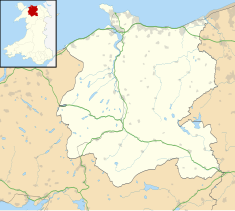Conwy Guildhall
| Conwy Guildhall | |
|---|---|
| Native name Neuadd y Dref Conwy | |
 Conwy Guildhall | |
| Location | Rose Hill Street, Conwy |
| Coordinates | 53°16′49″N 3°49′36″W / 53.2804°N 3.8268°WCoordinates: 53°16′49″N 3°49′36″W / 53.2804°N 3.8268°W |
| Built | 1863 |
| Architectural style(s) | Gothic Revival style |
Listed Building – Grade II | |
| Official name | The Guildhall |
| Designated | 8 October 1981 |
| Reference no. | 3251 |
 Shown in Conwy County Borough | |
Conwy Guildhall (Welsh: Neuadd y Dref Conwy) is a municipal structure in Rose Hill Street, Conwy, Wales. The guildhall, which is the meeting place of Conwy Town Council, is a Grade II listed building.[1]
History[]
The first building on the site was a medieval hall completed in the 13th century.[2] A new structure, which was arcaded on the ground floor so markets could be held, with an assembly hall on the first floor, was completed in 1613.[3] That structure was replaced by a national school in the early 19th century.[3] However, the national school moved to a new building further to the west along Rose Hill Street in 1840, and borough leaders decided to demolish the old school building and to replace it with a new civic building in the mid-19th century.[3]
The new building was designed in the Gothic Revival style, built in sandstone with Bath stone dressings and was completed in 1863.[1] The design involved a range with a gable end facing Rose Hill Street, a square tower to the right of the gable end and a flight of steps leading up from Castle Square to a porch.[4] Internally, the principal room was the council chamber.[1]
In the late 19th century, burgh leaders erected a public hall on the northeast side of Castle Street but this was largely used as an events venue, leaving the guildhall to continue as the main municipal building in the town.[5] The guildhall was extended to the south east to create a new council chamber in 1925.[1] The design involved a new range with a gable end facing Castle Street; the steps on the Castle Street elevation were removed and an elaborate porch was erected.[1] The new porch involved an arched doorway with a hood mould and carved quatrefoils in the spandrels, a panel inscribed with the word "guildhall" in antique lettering above the doorway, and a small pediment bearing a roundel with the borough seal above that; there was also a three light mullioned window to the right of the doorway.[1] On completion of the works, the old council chamber became the mayor's parlour.[1]
The former Prime Minister, David Lloyd George, who was a regular visitor to the area, arrived at the guildhall and met with borough leaders in the 1930s.[3][6] The town hall continued to serve as the headquarters of the borough council for much of the 20th century but ceased to be the local seat of government after the enlarged Aberconwy District Council was formed at Bodlondeb in Conwy in 1974.[7][8] However, the guildhall became the meeting place of Conwy Town Council instead and an extensive programme of refurbishment works was completed in 1996.[1]
Works of art in the guildhall include a portrait by John Dawson Watson of the former mayor, William Hughes,[9] a painting by Richard Wilson of Conwy Castle,[10] and a painting by Franz Emile Herman Krause depicting the rail accident which took place at Penmaenmawr in January 1899.[11]
References[]
- ^ a b c d e f g h Cadw. "The Guildhall (3251)". National Historic Assets of Wales. Retrieved 4 October 2021.
- ^ Johnson, Peter; Jefferis, Catherine (2016). Conwy and Around in 50 Buildings. Amberley Publishing. ISBN 978-1445661018.
- ^ a b c d "The Guildhall, Conwy". History Points. Retrieved 4 October 2021.
- ^ "Ordnance Survey Map". 1890. Retrieved 4 October 2021.
- ^ Cadw. "Entrance range of Conwy Public Library (3253)". National Historic Assets of Wales. Retrieved 4 October 2021.
- ^ Davies, John Barden (2017). A-Z of Conwy: Places-People-History. Amberley Publishing. ISBN 978-1445664392.
- ^ Local Government Act 1972. 1972 c.70. The Stationery Office Ltd. 1997. ISBN 0-10-547072-4.
- ^ "No. 46253". The London Gazette. 2 April 1974. p. 4323.
- ^ Watson, John Dawson. "William Hughes". Art UK. Retrieved 4 October 2021.
- ^ Wilson, Richard. "Conwy Castle". Art UK. Retrieved 4 October 2021.
- ^ Krause, Franz Emile Herman. "Rail Disaster at Penmaenmawr". Art UK. Retrieved 4 October 2021.
- Government buildings completed in 1863
- City and town halls in Wales
- Buildings and structures in Conwy
- Grade II listed buildings in Conwy County Borough
